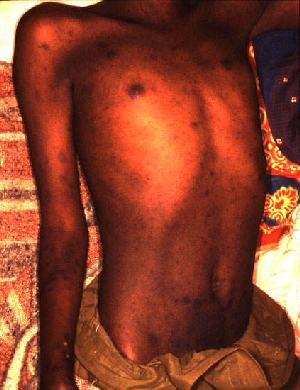settings
The Young Lions vocabulary
160 vocabulary words, including people, places, music, artists, etc.
help & settings
[x]
-
typhus
-
► definition
Definition:an infectious disease caused by a rickettsiæ bacteria and spread by fleas, lice, ticks or other nasty ichy vermin. Initial symptoms are similar to the flu, but within a few weeks a rash spreads from the trunk outwards. Left untreated it is often fatal. The disease was once very common in overcrowded slums and in prisons.---Signs and symptoms begin with sudden onset of fever, and other flu-like symptoms about one to two weeks after being infected. Five to nine days after the symptoms have started, a rash typically begins on the trunk and spreads to the extremities. This rash eventually spreads over most of the body, sparing the face, palms, and soles. Signs of meningoencephalitis begin with the rash and continue into the second or third weeks. Other signs of meningoencephalitis include sensitivity to light (photophobia), altered mental status (delirium), or coma. Untreated cases are often fatal.text from Wikipedia, licensed under Creative Commons - Attribution - Sharealike photo: Outbreak in Burundi. 1997, . Available from http://wwwnc.cdc.gov/eid/article/3/3/97-0313.htm Public Domain, https://commons.wikimedia.org/w/index.php?curid=209745
photo: Outbreak in Burundi. 1997, . Available from http://wwwnc.cdc.gov/eid/article/3/3/97-0313.htm Public Domain, https://commons.wikimedia.org/w/index.php?curid=209745
► uses
Uses:
“Well, and how was the old woman? I hope it’s not typhus?”
“Typhus it is not, but it’s taking a bad turn.”
---
It's a complete tragedy! They had hardly been married a month when— whew— her husband died of typhus. But that was not all. She caught typhus from him, and when, on her recovery, she learnt that her Ivan was dead, she took a good dose of morphia.
Anton Chekhov. The Duel and Other Stories
---
after my mother and father had been married a year, the latter caught the typhus fever while visiting among the poor of a large manufacturing town where his curacy was situated, and where that disease was then prevalent: that my mother took the infection from him, and both died within a month of each other.
---
“Typhus, sir. It’s death to go in.
Leo Tolstoy. War and Peace: With bonus material from Give War and Peace A Chance by Andrew D. Kaufman. Simon & Schuster

